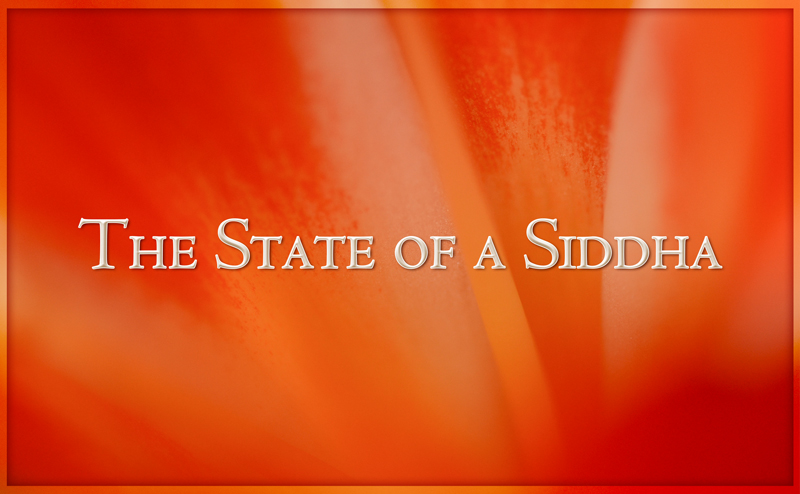The State of a Siddha

A Sharing by Swami Apoorvananda
In honor of Baba’s Month, which contains Baba Muktananda’s Birthday, I want to write about the state that Baba attained, the state of a Siddha, a perfected being.
Through the grace of his Guru, Bhagavan Nityananda, and his dedicated practice of meditation, Baba came to know and become one with the Self, the divine Consciousness at the core of one’s being. This state, of being established in the awareness of the Self, is the goal of the Siddha Yoga path. There is an aphorism in the Shiva Sutras which describes the state of a being who has become one with the Self.
The Shiva Sutras is one of the sacred texts of Kashmir Shaivism; Baba taught extensively from these texts, especially during his Third World Tour, which took place between 1978 and 1981. Baba loved Kashmir Shaivism as it so exquisitely described his experience of spiritual practice and spiritual attainment.
The aphorism from the Shiva Sutras says:
siddhaḥ svatantrabhāvaḥ
A Siddha lives in total freedom.
—Shiva Sutras 3.13
The Sanskrit term siddha means “achieved, accomplished, or perfected.” The term siddha is also used to refer to that yogi or perfected being who has achieved or accomplished the highest goal of sadhana: complete union with the Self. Baba was such a Siddha.
The term svatantrabhava means “the state of total freedom.” Bhava means “state” and svatantra means “free, independent, or relying on oneself alone.”
Svatantra is used to describe the nature of Consciousness. Because Consciousness creates the universe out of its own being, of its own will, and does not rely on anything outside of itself, it is said to be svatantra.
Therefore, the yogi who becomes one with supreme Consciousness—through meditation and other spiritual practices—lives in a state of freedom. Freedom is his or her constant experience.
Perhaps you have had a glimpse of this state yourself in meditation. You enter a deep space of inner absorption where you move beyond any sense of time or place or bodily sensation. Your being feels expanded and light. You come to rest in your own innate awareness, which you experience as unbounded, joyful, and free.
This is a taste of the Self, of your own true nature, and when you come out of meditation, you carry that freedom with you into your daily activities, at least for some time.
A Siddha is permanently established in this state of freedom and joy. And this state empowers such a being to engage fully in the duties of everyday life—to do so with energy, enthusiasm, and joy. I saw this with my own eyes around Baba, who bestowed grace and gave teachings on a daily basis.
And what moved me so much, the first time I met Baba in 1975 in the Siddha Yoga Ashram in Oakland, California, was that everything Baba did was full of delight.
Baba seemed to derive enormous joy from every gesture he made, every word he spoke, every step he took. And observing Baba’s joy in turn gave rise to great delight within me.
siddhaḥ svatantrabhāvaḥ
A Siddha lives in total freedom.
—Shiva Sutras 3.13
In his book Nothing Exists That Is Not Shiva, Baba comments on this sutra, saying that for each of us, there are two possibilities. One is to live in a limited or contracted state, unaware of our own true nature. The other is to attain the state of absolute freedom that arises from union with the Self.
Baba then describes how one attains the freedom of the Self. Baba says:
By the grace of the Guru, a person’s inner Shakti is awakened through the process of shaktipat. Unfolding, his Shakti fills him with consciousness and he gradually is freed from cravings and desires, the pull of the sense organs, and from all limited states. He achieves total union with the supreme Self.1
If you have received shaktipat initiation from Baba or Gurumayi, you may find that these words recall your own experience of Siddha Yoga meditation.
For example, in meditation, you may have felt the awakened Kundalini Shakti, the divine energy, expand and fill your entire being as she purifies you from within.
Or perhaps you have experienced great contentment arising from within, from the Self, when you practice meditation. Many people find that when they can access the source of contentment within, their attachment to certain outer desires falls away naturally.
I have found that over time—as I have immersed my awareness in the inner space of Consciousness again and again—I have come to shift my sense of identity from my mind to the Self. When limiting thoughts arise in my mind, I know they are not me, and I can let them go. This shifted sense of who I am anchors me in the truth.
These words from Baba provide us with a map of the inner journey, and a description of our goal. They are an invitation to commit ourselves to the practice of meditation—and to become established in the freedom of the Self, in the freedom that Baba embodied.
Happy Baba’s Month!
1Baba Muktananda, Nothing Exists That Is Not Shiva (South Fallsburg, NY: SYDA Foundation, 1997), p. 43.


